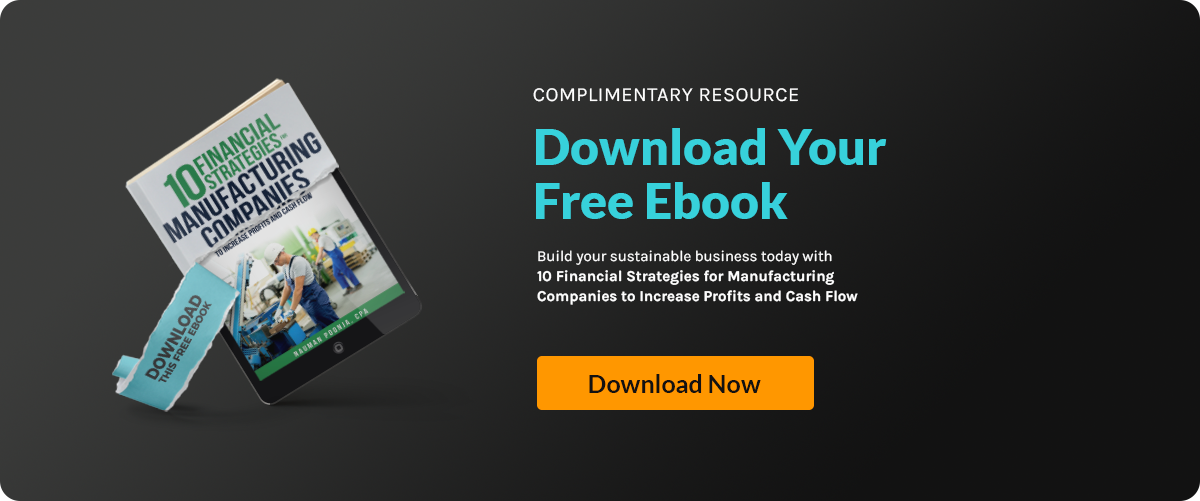Equity splits can build strong partnerships or destroy them. For founders, deciding how to divide...
A Founder’s Guide to Cash Flow Management for Manufacturing Success

For founders, growth starts and ends with cash. You can have steady sales, expanding operations, and new clients in the pipeline—but without reliable cash flow, none of it lasts.
Cash flow management is the backbone of financial stability. It determines whether your company can pay bills, fund production, and invest in opportunities without constant stress. For manufacturing founders, managing cash flow isn’t just about accounting—it’s about survival.
This guide breaks down how to understand, monitor, and optimize your cash flow like a CFO, using proven practices that keep manufacturing businesses agile and profitable.
Why Cash Flow Matters
Cash flow shows how money moves in and out of your business. It’s different from profit—profit measures performance, while cash flow measures liquidity.
A company can be profitable on paper and still run out of cash if payments are delayed or expenses rise suddenly. Manufacturing firms face this risk constantly due to large material orders, long receivable cycles, and seasonal demand.
Without proper management, cash gaps can halt production, delay payroll, and damage supplier relationships. That’s why mastering cash flow management is a founder’s top financial responsibility.
For a deeper dive into how cash flow shapes growth, see effective cash flow strategies every manufacturer needs.
The Three Types of Cash Flow
Understanding your financial statements starts with recognizing where cash comes from and where it goes.
1. Operating Cash Flow
Cash generated from day-to-day activities—sales, production, and service delivery. Healthy operations mean positive cash flow here.
2. Investing Cash Flow
Money spent on long-term assets like machinery or facilities. Temporary negative investing cash flow can be good—it means you’re investing in growth.
3. Financing Cash Flow
Capital raised or repaid through loans, investors, or dividends. Tracking this ensures your debt levels stay sustainable.
CFOs monitor these flows together using standardized cash flow statements to maintain liquidity without compromising profitability.
Common Cash Flow Challenges for Founders
Manufacturing founders face unique pressures that drain cash faster than expected:
-
Long Production Cycles – Materials, labor, and overhead pile up before you get paid.
-
Delayed Payments – Customers often stretch 30-day terms to 60 or 90.
-
Inventory Build-Up – Excess inventory ties up capital. See inventory carrying costs and their impact on cash flow.
-
Poor Cost Forecasting – Misjudging expenses leads to surprises that strain liquidity.
-
Seasonal Demand Swings – Cash reserves deplete during slow seasons.
Identifying these issues early helps you create systems that protect your working capital and smooth cash cycles.
Step 1: Build a Cash Flow Forecast
Forecasting is your first line of defense against surprises. A simple projection of expected inflows (sales, loans) and outflows (materials, payroll, utilities) gives visibility into your cash position.
Update forecasts monthly or quarterly using real data from your profit and loss statements and balance sheets. The goal isn’t perfection—it’s awareness. Companies that use rolling forecasts can adjust faster when costs rise or payments lag.
Step 2: Shorten the Cash Conversion Cycle
Your cash conversion cycle (CCC) measures how long it takes to turn investments in materials and labor into cash from sales.
The shorter your CCC, the stronger your liquidity.
Here’s how to reduce it:
-
Speed up receivables: Offer early-payment discounts or use digital invoicing.
-
Control inventory: Implement just-in-time production where possible.
-
Negotiate payables: Secure longer payment terms from suppliers without harming relationships.
To strengthen control over each stage, review financial alignment between manufacturing and supply chain.
Step 3: Separate Cash Flow from Profit
Profit and cash are not the same. Profit is an accounting outcome; cash is real money in your account.
A founder must watch both—but prioritize cash. A profitable order that won’t pay for 90 days can cripple your short-term liquidity. Use margin analysis and cost-volume-profit analysis to understand how production changes impact your real cash flow.
Step 4: Maintain a Cash Reserve
Unexpected events—a delayed shipment, equipment failure, or large tax bill—can wipe out liquidity overnight. A cash reserve acts as your safety net.
CFOs recommend holding at least 3–6 months of operating expenses in accessible accounts. Learn how to structure these reserves strategically through financial risk management planning.
Step 5: Automate Cash Tracking
Manual spreadsheets can’t keep up with the pace of manufacturing operations. Automation ensures accuracy and real-time visibility.
Integrated ERP systems and accounting automation tools link your inventory, sales, and payment data directly into your accounting system. This lets you see when cash shortages might occur and correct them before they affect production.
Step 6: Monitor Key Cash Flow Metrics
Cash flow management isn’t about watching your bank balance—it’s about tracking performance indicators that predict liquidity trends.
Key metrics to review include:
-
Operating Cash Flow Ratio = Operating Cash Flow ÷ Current Liabilities
-
Days Sales Outstanding (DSO) = Average Receivables ÷ Daily Revenue
-
Inventory Turnover = COGS ÷ Average Inventory
-
Current Ratio = Current Assets ÷ Current Liabilities
Regularly monitor these alongside financial KPIs to maintain healthy operations.
Step 7: Use Financial Modeling for Scenario Planning
Cash flow forecasting tells you what’s likely; financial modeling tells you what’s possible.
Model different cash flow scenarios—such as increased raw material prices or delayed payments—to prepare for fluctuations.
Explore how modeling and forecasting work together in financial modeling vs. forecasting.
Step 8: Control Costs Without Sacrificing Quality
Optimizing costs strengthens cash flow, but cutting the wrong expenses can hurt output. Instead, focus on operational efficiency—like optimizing labor and overhead costs and improving production planning.
Smart cost management means spending where ROI is clear and delaying non-critical upgrades until your cash flow supports them.
Step 9: Align Cash Flow with Growth Strategy
As your business scales, cash flow must evolve. Expansion requires upfront spending—equipment, hiring, and marketing—all before new revenue arrives.
Founders who plan cash flow alongside strategic capital allocation ensure their growth doesn’t outpace liquidity.
Growth funded without planning often leads to short-term debt and long-term instability.
Step 10: Partner with Financial Experts
Managing cash flow effectively requires data, discipline, and experience. Many founders outsource part or all of their finance functions to experts who specialize in manufacturing.
Outsourced accountants and fractional CFOs provide the financial leadership of a full-time executive without the overhead. They help analyze trends, manage forecasts, and build scalable financial systems.
This approach saves time, ensures accuracy, and provides CFO-level insight when it matters most.
Real-World Example
A custom fabrication startup in Ohio doubled its client base in 18 months but struggled with delayed receivables. Despite rising sales, the company faced monthly cash shortfalls.
By implementing an automated cash flow visibility system and renegotiating supplier terms, they reduced DSO by 22 days and stabilized working capital.
Within six months, the founder could confidently plan new investments without relying on emergency loans.
The Bottom Line
Cash flow management is not just an accounting exercise—it’s a leadership function. For founders, mastering it means gaining control over your company’s future.
Track your inflows and outflows, forecast ahead, build models for multiple scenarios, and automate wherever possible.
A predictable cash flow lets you operate from strength, not survival—freeing you to focus on growth, innovation, and opportunity.
Want to take control of your company’s cash flow?
Contact Accounovation to set up expert accounting and financial management systems that keep your cash predictable and your business growing.








